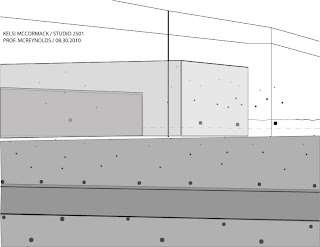
Sunday, September 26, 2010
Tuesday, September 21, 2010
Thursday, September 16, 2010
Sunday, September 12, 2010
Thursday, September 9, 2010
For An Architecture of Reality Reading
By: Michael Benedikt
- What is the reality Michael Benedikt writes about?
--Michael Benedikt writes about the reality of the known and unknown, the reality of dreams has an ending. The reality is physical and he shows how it relates with architecture. - Benedikt describes degrees of reality in architecture as: Architecture of Dreams, Architecture of Games, Architecture of Illusions, Architecture of Enactments and Architecture of Jokes. What are some example buildings that fall under these categories?
--Architecture of dreams - This type is relayed as imaginitive space with a surreal quality. An example building would be "Emilio's Folly: Man is an Island" by Emilio Ambasz
Architecture of games - This type is played out with rules and is a type that needs to followed. "The Manhatten Transcripts" by Bernard Tschumi demonstrates a good example of this.
Architecture of illusions - This type of architecture appears to be functional, when in reality is was built to give the illusion it serves a purpose but doesn't. A good example of this woud be a mural, on the Kroger building, in Cincinatti, by Richard Haas.
Architecture of enactments - The type of architecture this is where its a set, like a law would be, there are things that have to be done.
Architecture of jokes - This type is where its so basic and almost have a messy look to them it comes off child like. The construction of the building isnt something that seems to be professionally done. An example of this is a commercial building, in Austin, Texas by Arquitectonica. - Benedikt describes “direct esthetic experience of the real” as being moments without symbolism. Where in our environment does symbolism occur and where in our environment is symbolism absent? What is an example of this situation?
--Symbolism can occur in many places in our environment, some examples are our flag, its something that we acknowledge daily and has significance. Battlefields, such as jamestown, catholic churches and statues are a few other examples. Some things that have no symbolic meaning would be parking lots, spaces under electrical lines and a transformer box. - Although Benedikt’s position pulls examples from the 70‘s and 80‘s to illustrate that an architecture of reality is polar to the post-modern architecture movement, this condition continues to exist today. Where in the city would be examples of an architecture of reality and post-modern architecture?
--In Lubbock examples of architecture of reality would be rooftops, parking lots and sewer conditions. Some post-modern architecture examples are suburban houses, and even Las Vegas. - The four components that define the “realness” of an architecture for reality are: presence, significance, materiality, and emptiness (in two categories). How do these components relate to architecture? and What are some examples of architectural elements that make up these conditions?
--Presence -It is real to us, it speaks for itself. Presence works with its space like the purpose for being there is already known.
Significance - It has a collective value, to some people it has an immediate impact with its amount of value.
Materiality - This is how you use what is given, managing space and making things appear differently then what they are.
Emptiness - A containment of space, even if something is empty it still has a way of occupying space.
Field Conditions Reading
By: Stan Allen
- Stan Allen describes field conditions as “bottom-up phenomena: defined not by overarching geometrical schemas but by intricate local connections.” What are some field condition examples that can be found in the road systems of Lubbock?
--Some field conditions that can be found in Lubbock are stop signs at intersections, the road gravings because they have a consistant degree, and the layout in relation to a grid system.
2. In part 1, Allen distinguishes a geometric relationship of classical architecture from an
algebraic combination of the Cordoba Mosque. How do these two architectural examples
differ?
--Classical architecture relates to a whole, there is a system that is apparent. The Cordoba
Mosque started with one set condition, like an assembly line, and is grown from there.
3. What are some other examples of field conditions that can be observed around campus?
--Some of the field conditions you can find around campus are the paving, seating at the
football stadium, bike racks, and the parking lots having consistant spaces. All of these
have repeating patterns that make up a field condition.
4. How does a field condition stand to redefine the relation between figure and ground?
--Physical materials define the relationships as well as spacing. There is a consistancy and
two material conditions, it's a one to one relationship. Giambattista Nolli shows a great
example of this with his city plan of Rome, he takes figure ground and makes it useful.


























